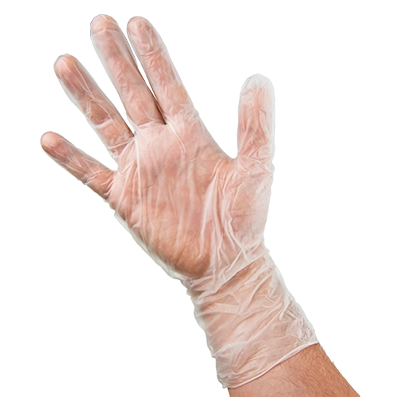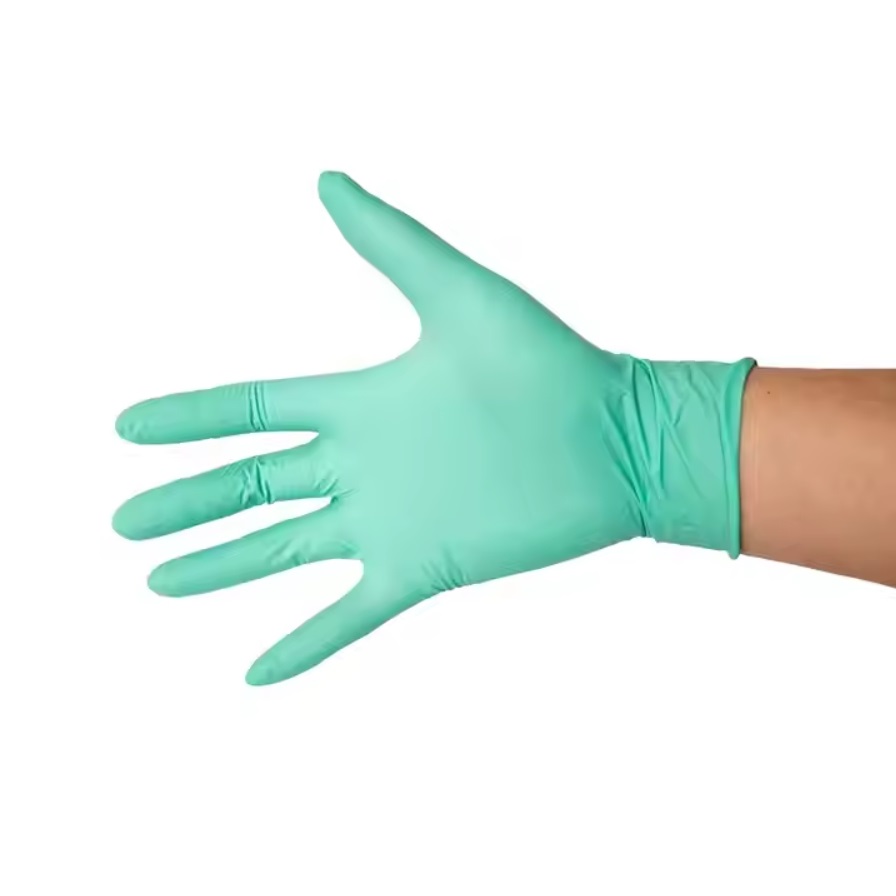What Does “Chlorine-Free” Really Mean?
When gloves are labeled as “chlorine-free,” it means they have not undergone the common chlorination process used to treat latex or nitrile gloves. Chlorination is a chemical treatment involving chlorine gas or a diluted bleach solution, intended to remove surface tackiness and make gloves easier to don.
While chlorination has historically improved glove comfort and shelf life, it comes with trade-offs, both for wearers and the environment. Chlorine-free gloves, in contrast, are manufactured using alternative methods that avoid harmful chemical residues, reduce ecological impact, and improve skin compatibility.
Terminology: Chlorinated vs. Chlorine-Free
| Term | Definition |
|---|---|
| Chlorination | A chemical process that treats gloves with chlorine to reduce tackiness and ease donning |
| Chlorine-Free | Gloves made without chlorine treatment, using mechanical or polymer-based smoothing methods |
| Low-Chlorine | Partially treated gloves with reduced chlorine exposure compared to fully chlorinated products |
How Are Chlorine-Free Gloves Made?
Instead of chlorine, manufacturers may use:
-
Polymer Coating: A layer of polyurethane or acrylic is applied to the glove’s inner surface, making it slick and skin-friendly without chemicals.
-
Mechanical Tumbling: Gloves are physically softened in large rotating drums with water or mild detergents, reducing stickiness through abrasion.
-
Silicone-Based Finishes: These lubricate the glove interior without affecting material performance or user comfort.
These techniques offer equal—if not better—performance without releasing chlorinated byproducts or altering the glove’s structure.
Why the Shift Away from Chlorination?
1. User Safety and Comfort
Chlorinated gloves can leave chemical residues that irritate sensitive skin. While this might not affect short-term users, extended or repeated contact (common in cleanroom or medical settings) can lead to:
-
Dryness and skin cracking
-
Irritation and contact dermatitis
-
Reduced glove elasticity and comfort over time
Chlorine-free gloves are gentler on the skin, hypoallergenic, and better suited for people with sensitive hands or chemical sensitivities. In medical and food service sectors, where gloves are worn for hours, this matters deeply.
2. Environmental Concerns
Chlorination produces chlorinated wastewater, which contains adsorbable organic halides (AOX)—a class of toxic compounds linked to environmental degradation. Improper disposal of such waste can harm aquatic ecosystems and contribute to long-term pollution.
In contrast, chlorine-free glove manufacturing:
-
Reduces wastewater toxicity
-
Supports cleaner, closed-loop production systems
-
Aligns with green certification standards (e.g., ISO 14001, REACH compliance)
Chlorine-free gloves are often preferred by companies pursuing sustainable procurement policies and carbon footprint reduction.
3. Material Integrity
Chlorine, while useful for making gloves easier to don, can degrade the glove surface over time. This can lead to:
-
Brittle or weakened glove films
-
Color fading (especially in dyed nitrile gloves)
-
Reduced shelf life under poor storage conditions
Chlorine-free gloves retain their structural integrity longer, especially in high-temperature or humid storage environments, making them more reliable for critical applications.
Industry Applications Driving the Trend
Medical & Healthcare
With increasing sensitivity to allergic reactions and chemical exposure, many hospitals and dental clinics now favor chlorine-free nitrile or latex gloves. These gloves reduce the risk of skin irritation for both patients and professionals.
Cleanrooms & Semiconductors
Any glove residue can lead to microscopic contamination in Class 100/ISO 5 or better environments. Chlorine-free gloves ensure no surface chlorides or residues are left behind, making them ideal for:
-
Wafer handling
-
LCD assembly
-
Micro-optics and lens manufacturing
Food Processing & Handling
Chlorine-treated gloves may carry residual odors or chemicals that affect food quality. Chlorine-free gloves eliminate this risk, meeting FDA 21 CFR standards for food contact without additional leaching or flavor alteration.
Sustainability in Action: How Leading Brands Are Responding
The global shift toward chlorine-free gloves isn’t just theoretical—it’s already shaping procurement and manufacturing policies in major companies across healthcare, food service, and cleanroom sectors.
-
Kimberly-Clark Professional®, a global leader in personal protective equipment, has committed to sustainable glove innovation by reducing chlorine use across its nitrile glove lines. Their RightCycle™ program also focuses on recycling nitrile gloves post-use, promoting circular economy principles.
-
Ansell, one of the largest glove manufacturers worldwide, has publicly stated its move toward low-chemical, chlorine-free production as part of its 2022 Sustainability Report. Their strategy includes reducing chlorinated wastewater discharge and achieving ISO 14001 certification across all glove manufacturing sites by 2025.
-
Fisher Scientific, a trusted supplier to labs and pharmaceutical companies, increasingly features chlorine-free nitrile gloves in its “Green Product” category, signaling a response to cleanroom clients demanding both chemical safety and environmental compliance.
These real-world transitions underscore a growing consensus: minimizing chemical exposure in glove production not only protects workers and end-users, it also meets rising ESG (Environmental, Social, Governance) expectations from global markets and regulatory bodies.
Comparing Glove Types: Chlorinated vs. Chlorine-Free
| Feature | Chlorinated Gloves | Chlorine-Free Gloves |
|---|---|---|
| Skin Sensitivity | May cause irritation | Hypoallergenic |
| Environmental Impact | Produces chlorinated waste | Environmentally safer |
| Shelf Life | Shorter in humid conditions | More stable over time |
| Comfort | Smooth, but residue-prone | Softened via coating or tumbling |
| Cleanroom Suitability | Limited | Ideal |
Final Thoughts
The rise of chlorine-free gloves isn’t just a marketing shift—it’s a necessary evolution in how we prioritize both human health and environmental responsibility.
Whether you’re operating a pharmaceutical cleanroom, managing a food production facility, or overseeing hospital supplies, switching to chlorine-free gloves signals a commitment to modern, ethical, and sustainable standards.
In a world where every particle—and every decision—counts, choosing chlorine-free is the smarter path forward.
Explore our collection of chlorine-free gloves engineered for cleanroom and healthcare precision.
References
-
Kimberly-Clark RightCycle Program







